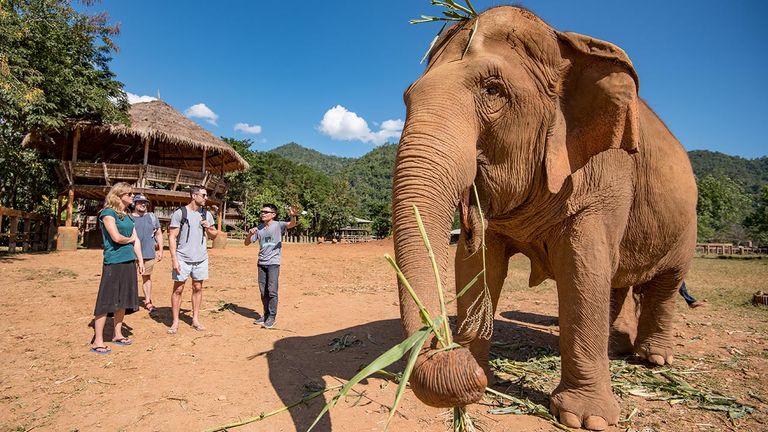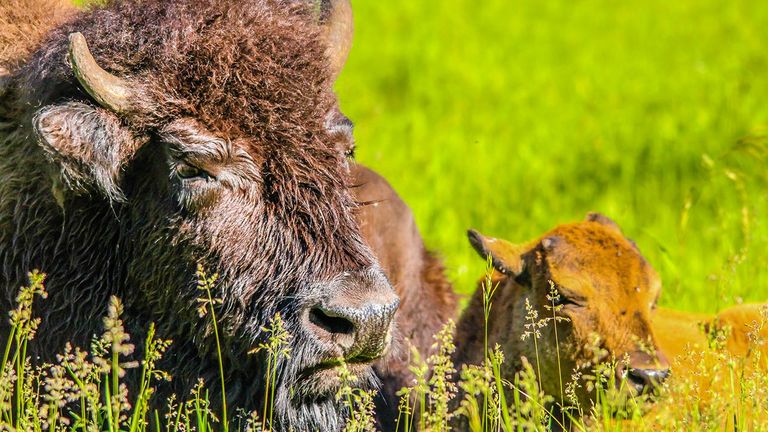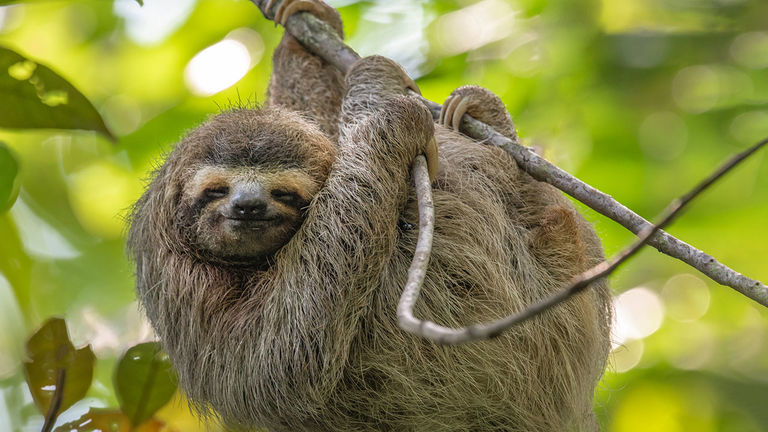Last year, I hiked to find chimpanzees in Rwanda, swam with dolphins in New Zealand and watched in awe as kangaroos bounded across Australia. My kids have pointed out monkeys in Costa Rica, giggled at lion cubs in South Africa and watched a family of whales swim alongside our boat in the Galapagos Islands.
None of these experiences would have been remotely as impactful through glass at the zoo.
Nothing captures a child’s attention like an animal and, while the cuter the better (hello, baby hedgehog), even the slimy and scaly variety can elicit a cloud of giggles. But that all changes if there’s any hint of something less than savory about their care.
Animal attractions have taken a lot of heat lately; for one, disturbing images of monkeys and other animals being trained to perform has caused an uproar. And complaints about confining animals has led Canada to introduce new legislation that bans keeping whales and other marine life in captivity.
Sign Up for Our Monthly Family Getaways Newsletter
I accept the T&C and Privacy Policy.
Intrepid Travel, one of the first tour operators to ban elephant riding on its Thailand trips, says it will become increasingly important for travel advisors to be able to weigh in with facts and information to help clients distinguish the good guys from the bad.
“Travelers appreciate being better informed and knowing that their travel choice is not causing harm to these extraordinary animals,” said Leigh Barnes, chief customer officer for Intrepid.
“Ethical tourism isn’t about reprimanding travelers who have participated in these activities in the past; it’s about what we can do to be better moving forward.”
To that end, advisors need to help clients identify responsible tour operators, Barnes says.
“A responsible tour operator is one that respects animals’ freedom from hunger, thirst, discomfort, fear, distress, pain, injury and disease, while giving them the freedom to express normal behavior,” he said. “Any operator that violates these standards should not be supported.”
There are benefits for kids who encounter animals in the wild, beyond the feeling that they’re doing the right thing. Mary Gordon, founder and president of Roots to Empathy, an organization aimed at fostering and nurturing empathy in children, notes that kids gain skills from animal encounters that help them become better human beings. When children see an animal in the wild and learn to care about its well-being, she says, they cultivate a skill that will serve them from the playground to the boardroom.
“Full empathy requires the blending of both affective empathy (the emotions and ability to care) and cognitive empathy, which is perspective taking,” Gordon said. “Exposure to animals has a lot more to do with the affective side, and that’s the side that’s least cultivated.”
Those empathic skills can combat loneliness and will help kids better understand and express their feelings, she says.
Included here are five of my favorite wild animal encounters, all of which provide a meaningful experience for clients while upholding today’s highest ethical standards.
 See polar bears with Natural Habitat Adventures.
See polar bears with Natural Habitat Adventures.
Credit: 2020 Getty ImagesPolar Bears in Manitoba
Want to capture a kid’s imagination? Show them a polar bear. Natural Habitat Adventures’ Churchill Arctic Family Adventure means the whole crew can have a winter adventure. From dog-sledding to a helicopter flightseeing tour, this trip to Northern Manitoba features opportunities for families to explore and appreciate the rapidly changing Arctic together. Throughout the trip, Natural Habitat guides help even the most junior wildlife explorer garner an appreciation for the rugged beauty of the Canadian tundra.
Perfect For: All ages
Next Level: Natural Habitat Adventures has curbed its own operational travel emissions since 2007, and began offsetting carbon emissions from its guests’ air travel in 2019. It’s also the world’s first 100% carbon-neutral travel company
www.nathab.com
Elephants in Sri Lanka
Elephant riding used to be a bucket-list experience for travelers to Southeast Asia. That has changed, thanks in large part to companies such as Intrepid. In 2010, the company partnered with World Animal Protection to conduct research on wildlife tourism venues in the region, and found that most using elephant entertainment were operating unethically. In 2014, Intrepid announced that it had removed elephant rides from all its trips, leading the industry by becoming the first global tour operator to do so. Since then, more than 200 other companies have followed suit.
One of Intrepid’s top ethical itinerary options is Sri Lanka Expedition: Wilderness & Wildlife, a 12-day tour that includes a mix of soft adventure in national parks and easygoing, beach-filled afternoons.
As part of the trip, guests visit Project Orange Elephant, an organization run by the Sri Lanka Wildlife Conservation Society. With support from The Intrepid Foundation, farmers here are encouraged to grow orange trees — a crop that elephants don’t eat — as a natural defense to protect farmland.
 Intrepid Travel has researched the most ethical options for seeing elephants.
Intrepid Travel has researched the most ethical options for seeing elephants.
Credit: 2020 Intrepid TravelThe orange tree barrier allows wildlife and humans to coexist peacefully.
Perfect For: Families with teens. This trip has a minimum travel age of 15.
Next Level: Intrepid has 21 offices across Africa, Asia, Europe and Latin America that oversee the company’s own sustainable, experience-rich tours. That gives it full quality control, ensuring tours are operated in the most ethical way possible.
www.intrepidtravel.com
Bison in Alberta
Once upon a time, there were more than 30 million bison across North America. During the 19th century, those numbers dived to under 1,000. Today, visitors will find more than 700 at Elk Island National Park, north of Edmonton, Alberta. Families here will also learn the story of what happened to the bison and how the animal’s plight is connected to the greater tragic past of North America’s First Nation people.
On the Bison Backstage Tour, guests walk through the first dedicated bison wildlife protection area in Canada, while discovering the history of the region that has been a home to bison for more than 8,000 years.
 In Alberta, clients can get close to bison in the wild.
In Alberta, clients can get close to bison in the wild.
Credit: 2020 Getty ImagesThe tour offers an up-close look at a working bison-handling facility, where the animals are protected by law and cared for by a team of dedicated professionals. The North American bison were brought back from near extinction and recognized as a keystone species of the prairies — integral to the flourishing of ecosystems. Animals from this disease-free facility have been sent around the world to help repopulate other areas from which herds had been depleted. Bison from Elk Island park have even traveled as far as Russia.
Perfect For: All ages
Next Level: Once the tour is over, families can take a self-drive excursion to see the animals in the wild. But caution clients to take care: The bison, which can weigh as much as a small car, roam freely among the 120 square miles; it’s not unusual for a bison to stand in the middle of the road and cause a traffic jam.
www.pc.gc.ca
Sloths in Costa Rica
Costa Rica is a longtime leader in sustainable tourism, and more than two-thirds of travelers to the country say they visit in order to engage in activities that are directly related to ecotourism. It’s no wonder, then, that the destination continues to top the list of best trips for families. From whitewater rafting to hiking in the cloud forest, clients are bound to bump into wild animals along the way — and a sloth encounter is a guaranteed highlight.
Sloths tend to hang out high in the trees, and getting a good look at one might put visitors and the animal at risk. Travelers’ desire for animal selfies led local entrepreneurs to domesticate wild animals and charge for the chance to hug, pet or offer food to them. Such behavior is now against the law in Costa Rica.
(The country also recently launched a #stopanimalselfies awareness campaign to discourage unsafe practices.)
Il Viaggio Travel is a family-run company that has won multiple awards for its ability to design inclusive multigenerational trips. Because the itineraries are bespoke, advisors can design a package that’s perfect for every family. And Il Viaggio’s ethical standards mean that clients are guaranteed a great experience while protecting the natural environment that makes Costa Rica so special.
Perfect For: All ages
Next Level: Las Pumas Rescue Center in Guanacaste is operated by a nonprofit foundation that offers a temporary home to the wild cats of Costa Rica when they’ve been injured, orphaned or confiscated by the illegal pet trade. Those that can be rehabilitated are returned to the wild. Visitors can take an educational tour or sign up to volunteer on projects at the center.
www.ilviaggiocr.com
 Costa Rica has limited tourists’ contact with wildlife, such as sloths.
Costa Rica has limited tourists’ contact with wildlife, such as sloths.
Credit: 2020 Getty ImagesOrangutans in Borneo
During a trip to Borneo with Exodus Travels, families can help save orangutans, an endangered species. The company’s nine-day Borneo Wildlife Family Holidays includes overnights in both a homestay and a traditional longhouse. Exodus also has its People, Places & Planet program, which focuses on initiatives that support community building, climate conservation and wildlife conservation.
Families on the trip visit the Kabili Sepilok Reserve Orangutan Sanctuary, where as many as 80 rehabilitated orangutans roam freely in the forest. The space was established in the 1960s to help provide medical care for orphaned and confiscated apes, and there is also a nursery for as many as 25 young orphans. Jungle walks and wildlife river cruises will further visitors’ appreciation for the region.
Perfect For: Ages 9 and up
Next Level: Stops at the Rainforest Discovery Center (dedicated to environmental education) and the Sun Bear Conservation Center (where the smallest bears in existence are protected) help round out the itinerary.
www.exodustravels.com